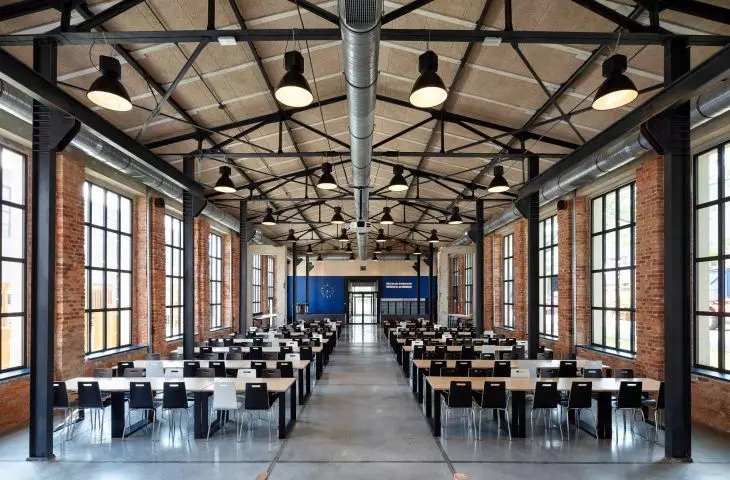Adaptation of post-industrial buildings to new functions is one of the most important issues of contemporary architecture - adapting to the transition from the industrial model to the information age. Architects from the GIGAarchitekci studio faced the challenge of creating such an adaptation.
Thefactory in the Silesian city of Orzesze dates back to the 19th century, although it is most often associated with the ZREMB plant as far back as the communist era. It was at these plants that concrete production equipment was developed for use in prefabricated "big plate" elements. After the plants were closed, the factory buildings fell into degradation. It wasn't until Danish transportation equipment company NT Industry undertook the work.
The company's new headquarters is characterized primarily by an attempt to minimally interfere with the building's structure. The distinctive brickwork, which has been cleaned and replenished, has been joined by other materials, such as the corten sheet used in the watchtower enclosure. The post-factory buildings were adapted primarily for new production and office functions.
this is what the building looked like before reconstruction
photo: Tomasz Zakrzewski, © GIGAarchitekci
Artur Garbula of GIGAarchitekci talks about the design process, the choice of technological solutions and the solutions used.
Wiktor Bochenek: Silesian Plant of Construction Mechanization "ZREMB" is a long, layered history. How do you relate to the tradition of the place?
Artur Garbula (GIGAarchitekci): The plant was an important point on the map of the city and an important employer. We had the opportunity to learn about the history of the place, and there was also contact with former employees. During the inventory, we came across decades-old props such as a drawing board and old machinery. A large part of the furnishings and witnesses of history were able to be preserved and excavated. Thus, the structure of, among others, the overhead crane, fragments of old installations were preserved, terrazzo on the staircases was renovated, and the divisions of the original window woodwork were reconstructed in the canteen.
canteen after reconstruction
Photo: Tomasz Zakrzewski, © GIGAarchitekci
Wiktor: What was the condition of the buildings before the work began?
Artur: The canteen was a storage hall. The office building was out of use due to its technical condition.
Wiktor: To what extent can we see interference with the fabric here, and how much can we see it being left behind?
Artur: The work on this subject was primarily about not breaking anything. In the interiors, falling plaster was removed and brick walls were exposed. Industrial floors were added in keeping with the original character of the buildings. Where possible, the original ones were retained. All new elements were designed to be a continuation and development of the site and its original character. New cubic elements accenting the entrances to the buildings were clad in corten cladding.
Recycled corten sheeting was also used
Photo: Tomasz Zakrzewski, © GIGAarchitekci
Wiktor: What are the ecological solutions used in the project that you mention?
Artur: Modern installations were introducedin the buildings, and good insulation of the partitions was taken care of. The whole building was plugged into a central heating system supplying the plant. The corten cladding used on the facades, in keeping with the idea of zero waste, comes from the unused material resources of the NT Industry plant and was entirely made by the Investor on the basis of technical documentation developed by our studio.
Wiktor: How were the functions and spaces divided in the revitalized building?
Artur: The office building was divided into different sized rooms adequately to the employment structure and the nature of work in accordance with the investor's wishes. The space was adjusted to modern standards, separating office rooms and intimate meeting rooms with glass walls. The canteen is an open space serving as the company's public canteen and a meeting place for employees. The part of the canteen directly adjacent to the office building was arranged for additional office space and a mezzanine with an accompanying recreational and office area.
The architects tried to preserve the character of the building
Photo: Tomasz Zakrzewski, © GIGAarchitekci
Wiktor: How was the communication between office spaces solved?
Artur: The office spaces are connected by a corridor, to which several common spaces and open office areas are also adjacent.
Wiktor: What was important when arranging the interior?
Artur: It was crucial to maintain consistency, get good sunlight, meet all today's formal and legal requirements while minimally interfering with the existing fabric. We also wanted to provide as much versatility as possible to the designed spaces - especially the main hall in the canteen. The interiors were given a modern, loft-like character. Anthracite-colored finishing elements were stylistically matched to the industrial character of the building. In addition, almost all interiors use wall panels and sound-absorbing ceilings manufactured from natural materials, which in addition to improving acoustic parameters also visually warm the space.
The project relies on intimate workspaces more than the open space popularized today
photo by Tomasz Zakrzewski, © GIGAarchitekci
Wiktor: What was the most difficult, and what are you most proud of?
Artur: The most difficult was solving the fire protection issues in the least visible way. We are most pleased with the corten cladding, which we managed to apply in an authoritative way - especially since all of it was recycled.
Wiktor: Thank you for the interview.
Exposing the brick was one of the goals of the investors and architects
Photo by Tomasz Zakrzewski, © GIGAarchitekci






































